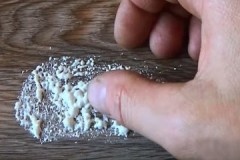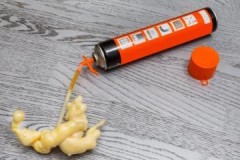A list of home recipes and chemical compositions, how you can remove polyurethane foam from doors
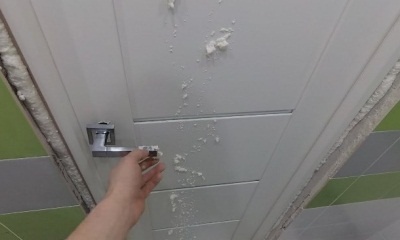 When installing doors for the purpose of sealing, polyurethane foam is used, providing high-quality filling of cavities due to good adhesion to surfaces.
When installing doors for the purpose of sealing, polyurethane foam is used, providing high-quality filling of cavities due to good adhesion to surfaces.
With the help of a special pistol, foam is blown out. And even with the most careful work, there is a risk of the foam mass getting on the door itself.
How to remove polyurethane foam from wooden, glass, plastic doors? Special preparations and home remedies will help to eliminate it.
Content
How to clean fresh?
The polyurethane foam used during installation has a viscous consistency at the time of application and has the ability to expand, filling holes and gaps. In air, the material begins to harden.
If flakes of polyurethane foam hit the door itself, you can remove them before they set. But in the areas of the joints, it is advisable not to touch the sealant so as not to violate its insulating ability.
The bulk of the fresh polyurethane foam hitting the door can be removed with a plastic spatula or wooden scraper... It is necessary to make the instrument clear, sharp movements, without smearing the composition over an even larger area.
The rest of the sealant will help remove the solvent. The most harmless way is to use rags soaked in vegetable oil for this. But you can use other means as well. In this case, it is imperative to take into account the material of the door itself.
 In most situations, the following drugs are suitable:
In most situations, the following drugs are suitable:
- technical liquid White spirit;
- acetone-containing compositions;
- table vinegar;
- purchased polyurethane foam cleaners.
Fresh foam must not be washed off with water, as contact with any damp surface will accelerate adhesion and hardening.
How to remove with improvised means?
In most cases, homemade recipes are just as effective as special cleaners when removing sealant on the door. In order for any solvent to work, it is necessary to prepare the surface - cut off the bulk of the foamed sealant.
And only after that do they move on to rubbing off the trace.
Dimexide
Dimexidum purchased at the pharmacy is a product that can be used as a solvent.
They use it in its pure form according to the following algorithm:
- Apply Dimexide to a sponge or rag and thoroughly saturate the stain.
- Keep the composition on the door for just a couple of minutes.
- Wipe off the softened mass with a rag, helping yourself with a plastic scraper.
Removing polyurethane foam from the door using Dimexidum - in the video:
White Spirit
White spirit solvent is suitable for combating various types of contaminants by acting as a solvent. The product is applied to the stained area and left for 30-60 seconds. The softened foam is washed with a rag.
Vegetable oil
 Vegetable oil helps to quickly remove fresh dirt... But with dried foam, the effect is much weaker.
Vegetable oil helps to quickly remove fresh dirt... But with dried foam, the effect is much weaker.
It is not worth trying to wash off a thick layer of foam sealant - the oil will not be able to soften it, so cutting off the main drop is a must.
It is convenient to use a rag to apply the composition to a vertical surface. After a few minutes, try to pry off the sealant with a scraper.
Vinegar
Table vinegar, due to the presence of acid, can be used as a solvent... Apply it undiluted. Apply the vinegar with a napkin and give it time to take effect. When the mass becomes soft, it is cleaned off.
Top 3 special drugs
Manufacturers of polyurethane foam and other types of sealants simultaneously produce cleaning preparations. The use of special tools allows you to clean the assembly gun and remove any dirt that accidentally got on the door surface.
Soudal PU Remover
This product is sold in a small container, it is suitable for cleaning various surfaces from foam residues.
The set includes:
- the product itself in a jar;
- putty knife;
- brush.
It is convenient to apply and distribute the preparation with a brush, and wash off the remaining foam with a plastic spatula. There is also a limitation - Soudal should not be used as a remover on:
- brass,
- copper,
- zinc metal surfaces.
The cost is about 600 rubles per 100 ml.
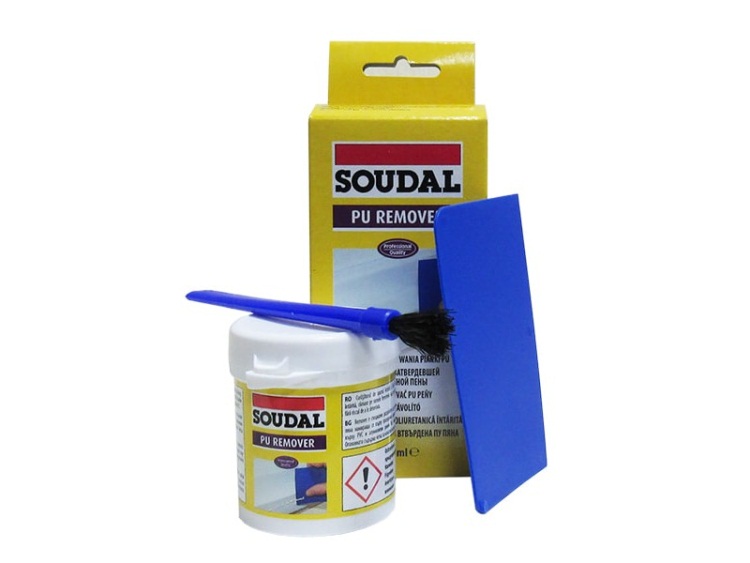
Penosil Cured PU-Foam Remover
The cleaner is highly effective product that is available in an aerosol can... The solvent is designed to remove hardened polyurethane foam from:
- doors,
- door frames,
- windows, etc.
Using Penosil allows you to remove dirt from accidental staining during installation. It is a one-component, easy-to-use product. The manufacturer also has a separate cleaner for removing uncured foam. Price - from 300 rubles.
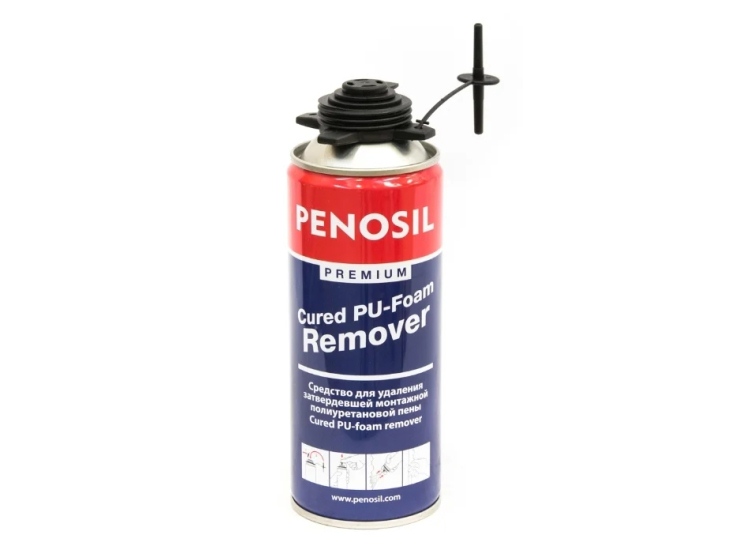
Profflex
Profflex is intended for removing uncured polyurethane foam and cleaning the gun itself. The preparation is suitable for processing:
- doors and windows,
- slopes,
- clothes, etc.
Cleaning of mounting structures is carried out using a spray adapter. The cost for 0.5 liters is about 120 rubles.
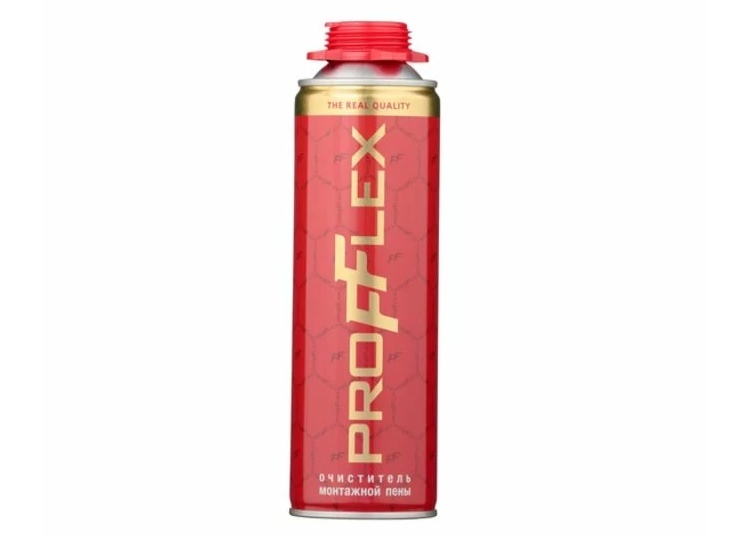
Features of cleaning various materials
It is not difficult to remove the foam remaining after installation from the door, if we take into account the peculiarities of the material from which it is made. If several types of materials are used, the nuances of processing each should be taken into account.
Metal
Metal doors from polyurethane foam can be cleaned with special solvents, Dimexidum or any other means. The selected product is applied for a quarter of an hour, after which it is removed with napkins or rags.
Wood, MDF
Wooden doors coated with varnish are most conveniently removed from foam marks not immediately, but wait for the sealant to harden. When the foam is rubbery in consistency, the mark can be removed by prying the edge.
If the trace still remains on the surface, it will have to be finished with a cleaner, pharmacy Dimexide or another solvent.
Eco-veneer
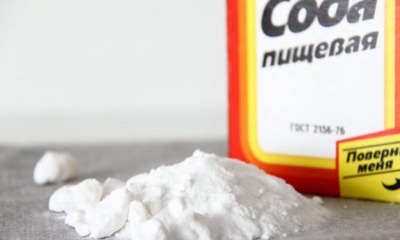 By its composition, eco-veneer is a composite material, which contains wood chips and a synthetic component.
By its composition, eco-veneer is a composite material, which contains wood chips and a synthetic component.
It is not worth cleaning such a door with Dimexide, since there is a threat of damage to the structure of the door itself.
Since the material has a sufficiently high resistance to mechanical stress, then a baking soda and wet sponge cleaning approach can be used... White spirit is also suitable.
Wiping off dirt from an eco-veneer may require the application of effort, since the material has a textured uneven surface.
Glass
Glass inserts are most often found on interior doors. Like other surfaces, glass can be stained with fresh foam. If splashes are noticed immediately, they can be easily removed with an oiled cloth.
Lean oil is best applied to dirt for a quarter of an hour. - so the effect will be higher. After that, greasy stains from the glass are easily removed with soapy water and any means for washing mirrors and glass.
Plastic
Foam from plastic doors can be removed with a table bite. It is applied to the stain and tinder. Special polyurethane foam cleaners will also help to clean the surface.
4 prohibitions
When cleaning doors from polyurethane foam, the following prohibitions must be taken into account:
 Do not work with bare hands. The solvents used easily come into contact with the skin, and the foam itself can adhere to it.
Do not work with bare hands. The solvents used easily come into contact with the skin, and the foam itself can adhere to it.- It is not advisable to cut off dried foam with a knife to the very base, as this increases the risk of damage to the door material.
- Solvents should not be left on the surface to be treated longer than recommended by the manufacturer, as this can damage the door itself.
- You should not try to wash off fresh foam with water, as this will only harden it faster.
5 useful tips
When removing traces of foam the following advice from specialists involved in door installation will help:
- If you don't have a plastic scraper on hand to remove any remaining foam, you can use an old bank card.
- Before applying the solvent to the center of the door, try the product, preferably on an inconspicuous area. Solvents can give different results on different types of surfaces.
- Before applying polyurethane foam, make sure you have products available that can be used as sealant solvents.
- When choosing a special stain remover, it is better to give preference to the preparations of the same company that produces the foam used when installing the door.
- Not all specialty foam cleaners have the same effect. Among them there are those that are focused on the elimination of fresh composition and those that are intended for hardened.
You will find useful tips and advice on how to remove polyurethane foam from various surfaces and objects here.
Conclusion
It is possible to remove polyurethane foam from doors at any stage of its hardening. When cleaning the surface, it is necessary to take into account both the features of the door material and the nuances of using the selected means. If you strictly follow the rules and do not use force, foam can be eliminated even in very difficult cases.


